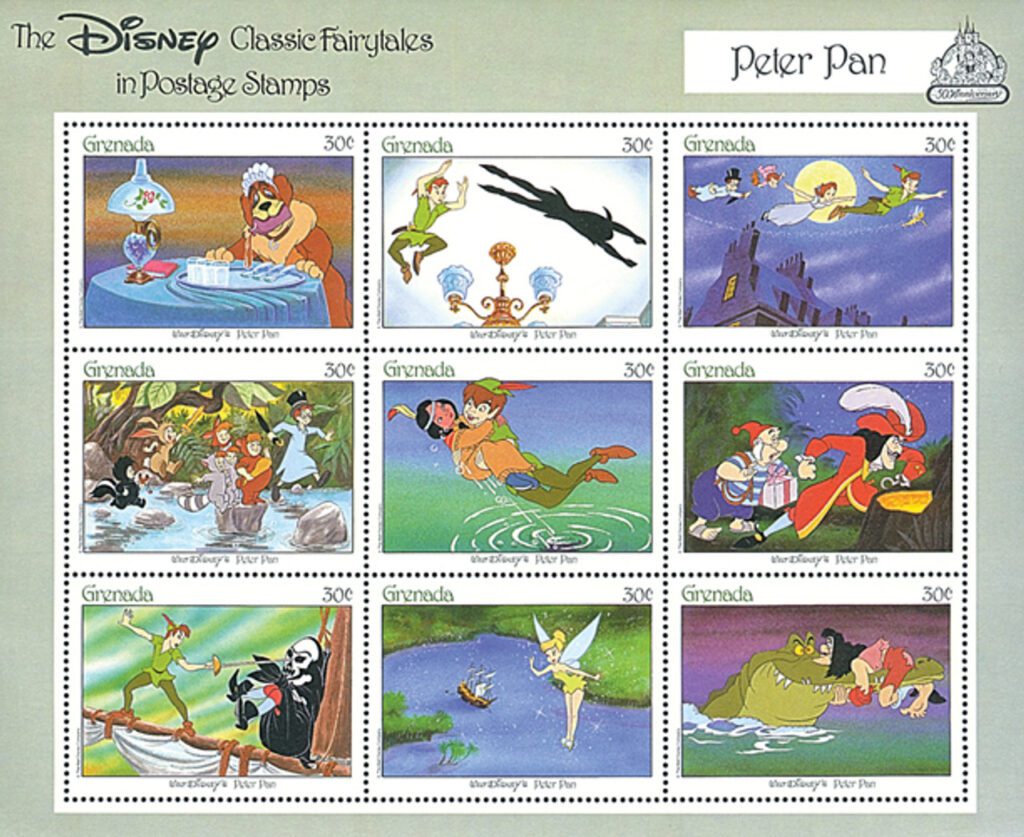On February 5, 1953, Walt Disney released his 14th animated feature – Peter Pan.
J.M. Barrie (1860-1937), born in Kirriemuir, Scotland, was the second youngest of nine children and the author of Peter Pan. Barrie created Peter Pan through a series of stories he told the young sons of his close friend, Sylvia Llewelyn Davies. In fact, the main character was named after one of Davies’ sons, and also the playful Greek god, Pan. The story of Peter Pan was first written as a play in 1904, and then as a novel titled Peter and Wendy in 1911.
Walt Disney had loved the story of Peter Pan for a long time – it was one of his favorites. So in 1935 he planned for it to be his second animated feature film (after Snow White). However, it took four years of negotiations to finally get the rights. In 1939, his studio began working on the story and character designs. However, after the U.S. joined World War II in December 1941, the studio was commissioned to make war propaganda films, and Peter Pan was among several projects to be put on hold.
With the war over in 1945, the studio was in debt and it would be two more years before they could afford to resume work on Peter Pan. It’s an accepted rumor that Captain Hook was a self-caricature of animator Frank Thomas, while his sidekick Smee was a self-caricature of animator Ollie Johnston. It’s long been rumored that Tinker Bell was fashioned after Marilyn Monroe, but in reality model Margaret Kerry was animator Marc Davis’ official model.

Peter Pan premiered on February 5, 1953 and received largely positive reviews in America. But British viewers (as well as some American critics) found fault with the liberties taken by Disney, failing to understand the different demands of stage and film. Animation, of course, afforded infinitely greater flexibility than the stage did.
The animated film made Barrie’s visions a reality. Audiences could finally see the more fanciful characters (Tinker Bell the Fairy and Tick-Tock the Croc), as Barrie had wanted them to be seen. Thus, in Disney’s Peter Pan, not only do we see Peter’s shadow, we see it moving independent of Peter. We see a lovely, coquettish Tinker Bell who pouts and is spiteful when jealous. We delight as she flits from place to place with the movement and speed of a hummingbird, leaving a trail of sparkling pixie dust in her wake. In the play version, Tinker Bell couldn’t be anything more than a moving beam of light. In Disney’s Peter Pan, we see Nana as a real, tray-carrying dog, something next to impossible to duplicate on stage. We also see a real crocodile, the perfect foil for the evil Captain Hook – much more satisfying than just hearing a loud ticking clock. When animated, all the characters became larger than life, their true natures visually apparent.
Peter Pan went on to become the highest-grossing film of the year, earning $7 million. It was so popular with audiences that it was re-released in theaters several times in the ensuing decades.
Discover what else happened on This Day in History.


Like the peanut butter too!
Thanks again for the daily history lesson and insight to so many interesting subjects. Keep ’em coming.
I WONT GROW UP!!
I don’t want to go to school!
The theme of lost childhood makes this film a bit sad. But, it was the first film I truly loved. I still miss Walt Disney.
I love the Disney Postage Stamps that I have a book “The Art of Disney Stamp Book” that I bought it from USPS Postal Store Online on 2015.
I don’t want to go to school!